Blog Archives
Lone cygnet for this Black Swan couple
A pair of Black Swans in my neighbourhood has a single cygnet this year. Baby black swans are so cute! An adorable bundle of grey-cream fluff with black beaks, eyes, and legs:
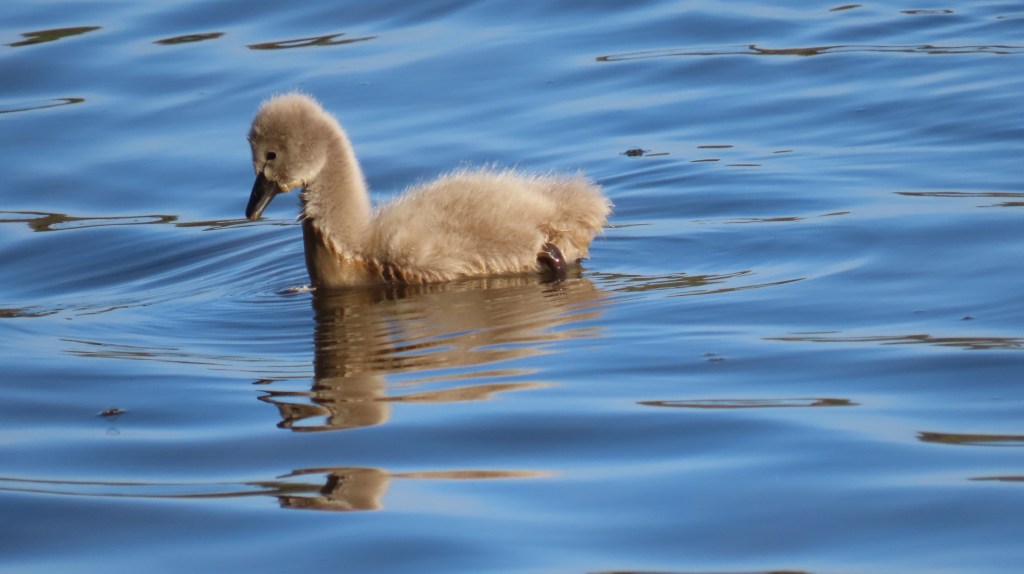
I don’t know how many eggs there were in the brood, nor how many of them hatched. Alas, baby swans are prey to several natural predators, especially hawks and eagles, as well as to introduced animals like dogs, cats, and foxes.
Here’s the baby and one of the adults, in a lovely mellow lighting:

It’s good to see any young swans at all — I didn’t spot any last year. In fact, I watched a pair of swans devotedly tend their nest for eight months without hatching any eggs! It’s possible they were both males, practising their nesting skills together in the absence of any females. I wrote about their vigil in two posts: part 1 and part 2.
So it’s great to see these two adults looking after the little one:
Common name: Black Swan
Scientific name: Cygnus atratus
Approximate length of adult bird: 120 cm
Date spotted: 25 November 2025 (spring)
Approximate location: Sydney’s Northern Beaches, New South Wales, Australia
Sooty Oystercatcher
Every now and then, I spot an Oystercatcher on one of the rocky plates on our sea shores. They’re usually hard to photograph, being such a sooty black and usually keeping far away from humans. This weekend, two of them broke the pattern.
I was in Wollongong, on the east coast of Australia just south of Sydney. Two Sooty Oystercatchers were pottering around on the rocky plate right next to the beach, prying food out of the crevices. This video shows only one of the birds:
They have long thin beaks, a striking orange in colour. Their eyes are ringed in a matching orange, and their legs are pinky-orange too, turning to yellow around the toes.
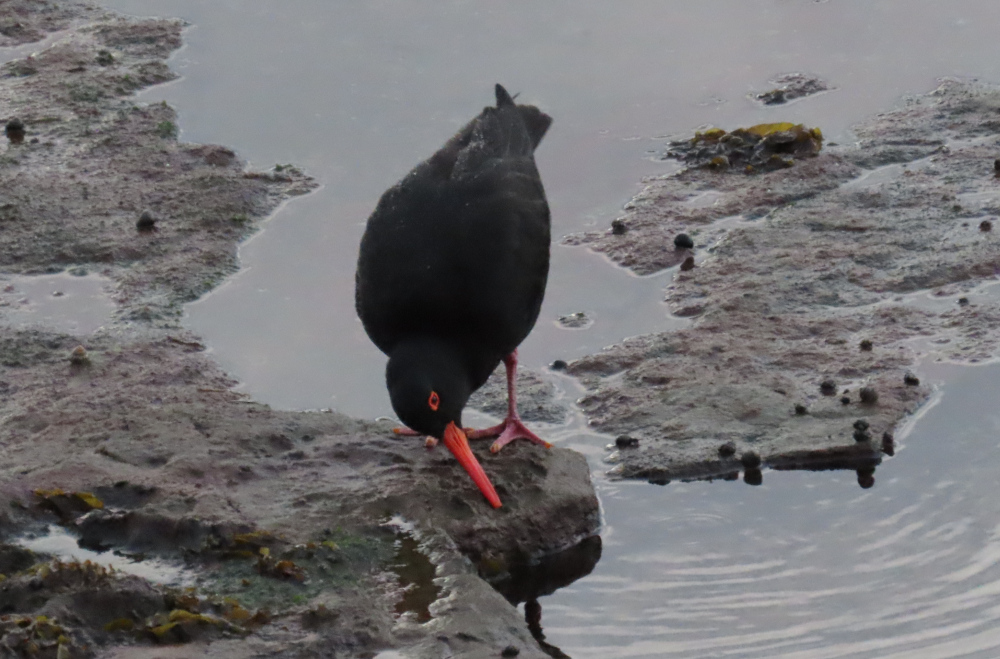
These birds are listed as uncommon, and scarce on disturbed beach areas. It’s good to see them just doing what Oystercatchers do.
Common name: Sooty Oystercatcher
Scientific name: Haematopus fuliginosis
Length: 40-52 cm
Date spotted: 9-10 August 2025 (winter)
Location: Wollongong, New South Wales, Australia: 34°25’04.4″S 150°54’08.8″E
White-faced Heron stretching
In the morning sun, a White-faced Heron stretches his wing. The decaying wood of his perch mirrors the pattern of his stretch.

Common name: White-faced Heron
Scientific name: Ardea novaehollandiae
Approximate length: 66-69 cm
Date spotted: 20 June 2025 (winter)
Location: Manly Dam, New South Wales, Australia: 33°46’34.0″S 151°14’48.5″E
Muscovy ducks meet a Brush-turkey
Two Muscovy ducks hiss and wag their tails to warn off an Australian Brush-turkey. The Brush-turkey had been investigating my shoes, then it decided to see what the two interesting ducks were up to. The encounter ends peacefully. No feathers flying this time!
Muscovy ducks come from the Americas, and are actually more like a cross between a goose and a duck than just a duck. They hiss like geese, although it’s a very quiet hiss. Their faces and heads look like geese, but their body shape is more like a duck’s.
I’ve seen this pair of Muscovies at Manly Dam often — they’ve made this area their home.
Common name: Australian Brush-turkey and Muscovy duck
Scientific name: Alectura lathami (Brush-turkey) and Cairina moschata (Muscovy)
Approximate length: 60-70 cm (Brush-turkey) and 76–84 cm (Muscovy)
Date spotted: 29 April 2025 (autumn)
Location: Manly Dam park, New South Wales, Australia: 33°46’44.9″S 151°14’58.4″E
Osprey nests at Rat Park
For a couple of years, I’ve been reading about the Ospreys that nest high on the lights at Rat Park in Warriewood, in Sydney’s Northern Beaches. The birds have earned their fame by returning year after year to the same spot. They build their nests and raise their young in what seems an unlikely and uncomfortable perch, twenty metres above the playing fields. So I went to take a look at them.

Ospreys are magnificent birds, with their large size and impressive fishing skills. They’re listed as vulnerable in NSW. Their numbers were in decline until the 1970s, but the great news is that they’re on the rise now.
Here’s a close-up of the same Osprey on the lamp post:

This photo shows the same nest from the other side:
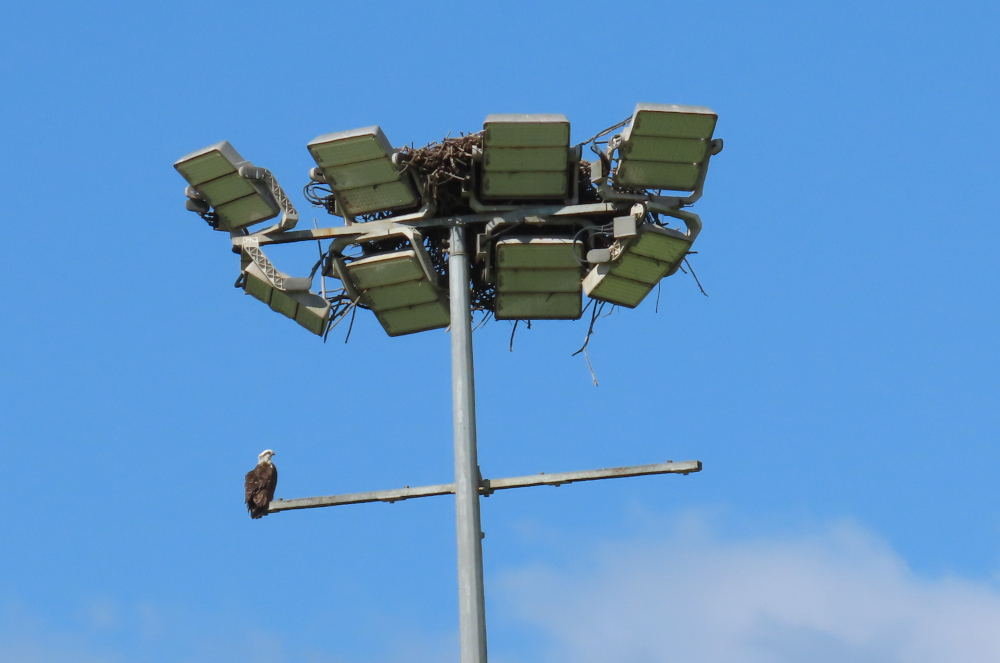
Zooming out to show the playing field and the 20-metre lamp post with the nest on top:

There were nests on top of a couple of the other lamp posts too, but no Ospreys tending them while I was there.
Here’s a front view of the Osprey with the sun behind it:
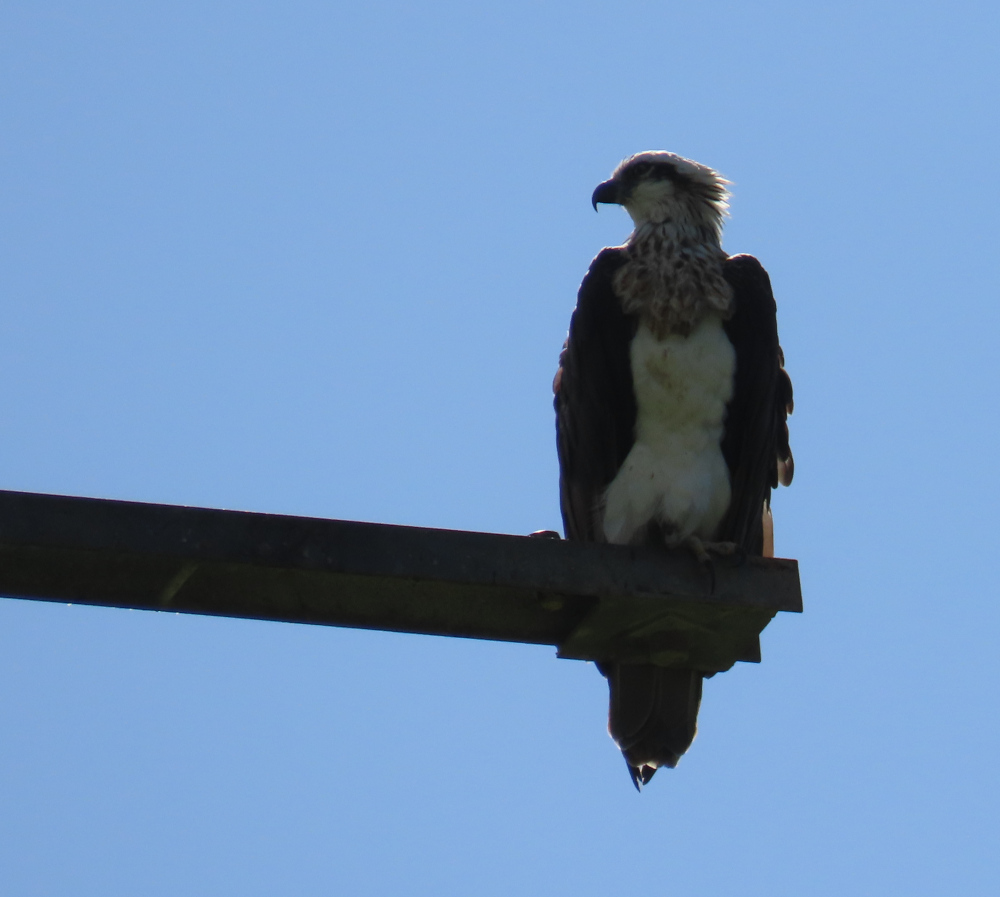
I’ve been lucky enough to see Ospreys a few times, most often at the Long Reef Aquatic Reserve in Collaroy. The Manly Observer has reported on the Ospreys of Rat Park, and they’ve featured on several other sites including Facebook.
Common name: Eastern Osprey
Scientific name: Pandion cristatus
Approximate length: 57 cm
Date spotted: 4 April 2025 (autumn)
Location: Rat Park, Warriewood, New South Wales, Australia: 33°41’50.6″S 151°18’21.8″E
Longest nest-sitting ever: Black Swans abandon nest after 8 months (part 2 of story)
Over the past 8 months, two Black Swans have been diligently tending a nest in Manly Dam Park, in Sydney’s Northern Beaches. In the early days (August 2024), spring was in the air. Nature was blooming and the swans were devoted and diligent. As spring turned to summer, the heat bore down. Cicadas shrieked, reeds grew up and died down again. Still, the pair tended the nest, rebuilding regularly, looking after each other, and clearing the water around their nest. (Story of two nesting Black Swans: Part 1)
Yesterday (9 April 2025), for the first time, the nest was empty when I walked past. The nest is the large circle of brown reeds lying horizontal behind the green reeds:

A hundred metres away, one of the swans was drifting on the water, hooting quietly and persistently:
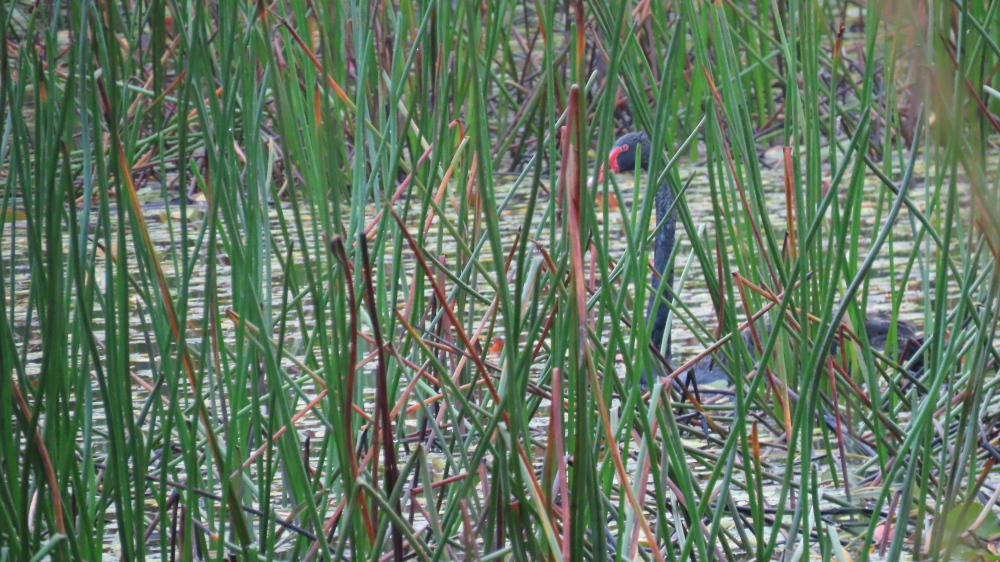
Once or twice I heard the other swan replying from deep in the reeds, but I didn’t see it.
At my previous visit a week ago, the swans had moved their nest to a slightly different location, just ten metres or so away from the original location. I wondered if this meant that at last, there was hope for an egg or two. Who knows, perhaps the pair will proudly emerge with a train of cygnets to show. Alas, though, I doubt that there were ever any eggs in the nest. From a discussion on Reddit, it seems that the most likely explanation is that the swans are two males, practising nest-building and nest-sitting in the absence of a female to lay an egg.
Here’s a photo from October 2024, showing both swans at the nest:

Here’s one of the swans in early February 2025, off shift for a moment while its partner sits on the nest:
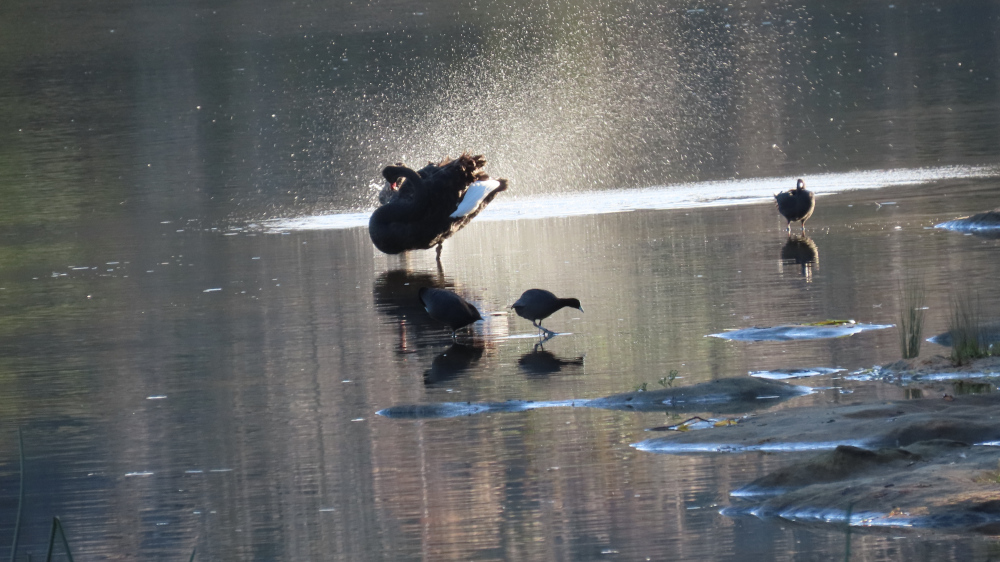
This is the tranquil site of the nest, now empty, but ready perhaps for a new attempt come spring:
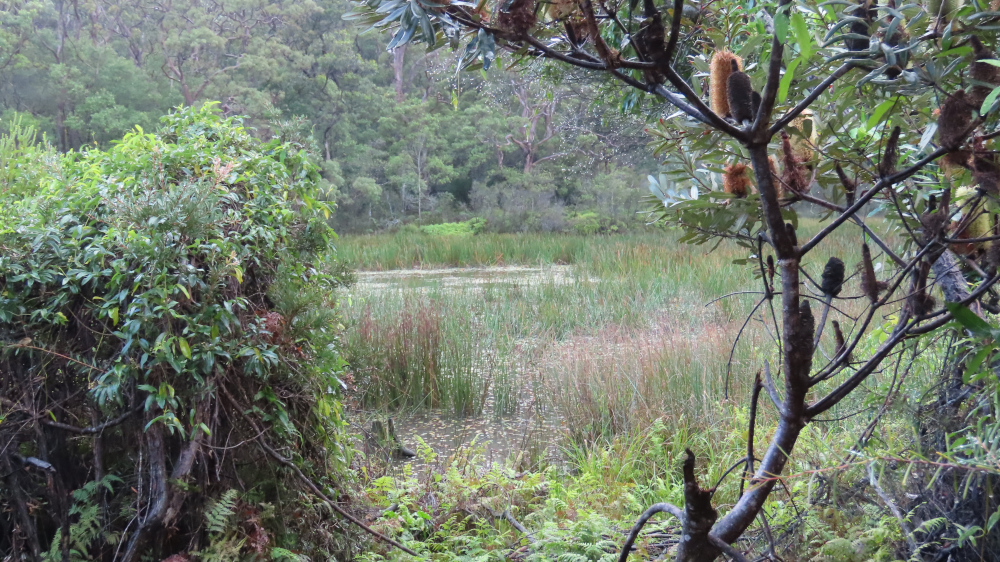
Common name: Black Swan
Scientific name: Cygnus atratus
Approximate length: 120 cm
Date spotted: 23 August through to 9 April 2025 (late winter, through spring and summer, into autumn)
Approximate location: Manly Dam Park, New South Wales, Australia
Lost! Baby Purple Swamphen
A baby Purple Swamphen hops around the lily pads, sticking close to the safety of her mother. But where is her little brother?
I love the baby birds’ tiny little wings. They look like little arms flapping about. At first, I thought that the baby had caught a frog. No, it’s just those little wing stubs.
But where is her brother? Another tiny little Purple Swamphen is lost amongst the reeds! It’s hard to see how such a tiny thing can find his way back to his mother and sister, so far away among the giant lily pads:
I don’t know whether these birds are male or female, so I’ve just picked pronouns at random. Both sexes of Purple Swamphens look after their young, and they’re hard to tell apart.
Mother might not have the most beautiful face, but she offers safety and comfort:
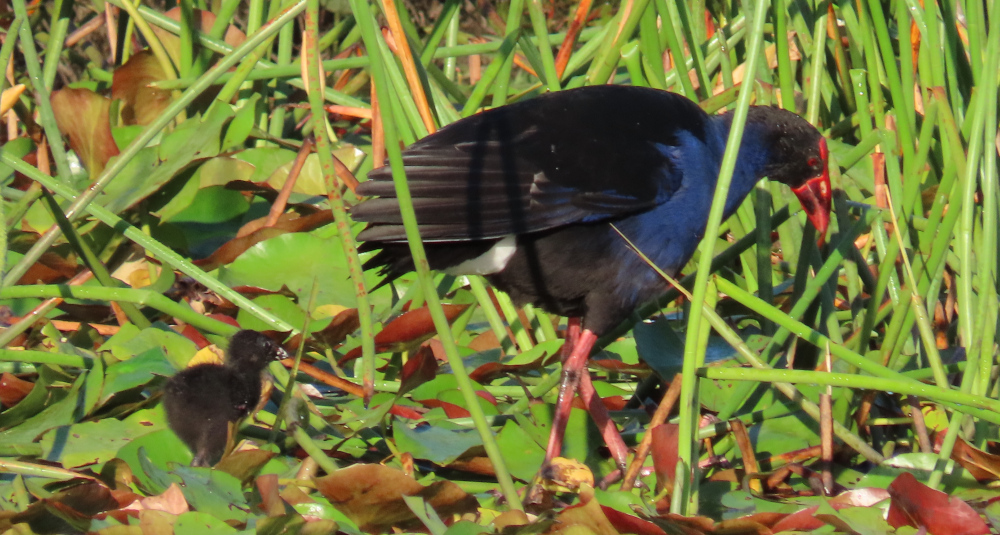
Will the little one find his way back? His sister gazes across the lily pads, as if searching for him:
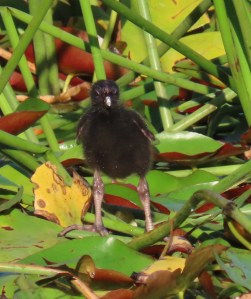
At last, the wanderer spots his family and hurries across the lily pads. His sister greets him warmly, while mother looks on fondly:
Common name: Purple Swamphen
Scientific name: Porphyrio porphyrio
Approximate length of adult: 50 cm
Date spotted: 5 February 2025 (summer)
Location: Manly Dam Reserve, New South Wales, Australia: 33°46’35.4″S 151°14’49.1″E
A beautiful orange cormorant
Usually, Little Pied Cormorants have bright white and shiny black feathers. This one, though, has a lovely burnished orange head and chest. This is probably due to staining from natural iron deposits in the water.


Here’s a short video, showing the back of the bird’s head with a neat black stripe between the orange feathers of the bird’s face:
Common name: Little Pied Cormorant
Scientific name: Phalacrocorax melanoleucos
Approximate length: 60 cm
Date spotted: 20 January 2025 (summer)
Location: Manly Dam, Allambie Heights, New South Wales, Australia: 33°46’35.1″S 151°14’48.5″E
Story of two nesting Black Swans: Part 1
This is part 1 of a story about a pair of nesting Black Swans. At this point, I’m concerned about the state of the swans’ eggs. I don’t know what part 2 will hold, but I do hope for a happy ending.
These two swans have been sitting on their nest since late August. I first saw them sitting on 23 August, and a park ranger told me that they’d been sitting for at least a few days by then. It’s now 9 December. That’s more than 15 weeks — more than 105 days.
The eggs of Black Swans usually hatch after 39-45 days.
This photo is from the first time that I saw the nest, on 23 August:
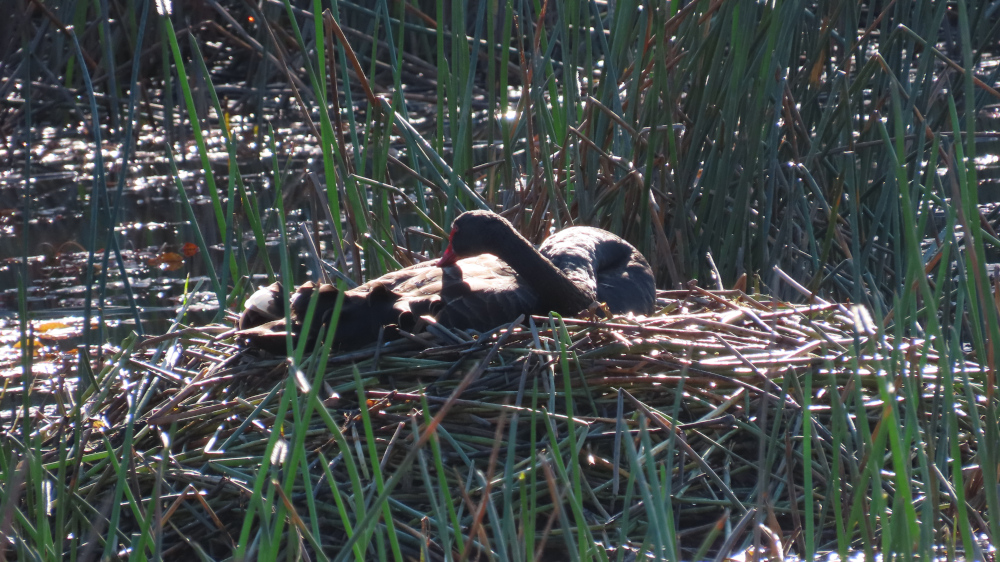
(Photo taken on 23 August 2024)
The swan’s nest is a large pile of reeds, positioned in shallow water in the middle of a large reed bed. It’s quite a distance from the shore on both sides, and well screened from entrance on the water too. From the shore, it’s not possible to see into the nest. I’m assuming there are eggs, because the swans are very diligent about sitting on the nest and occasionally it looks as if they gently prod the eggs with their beaks.
Here’s another photo from the early days:
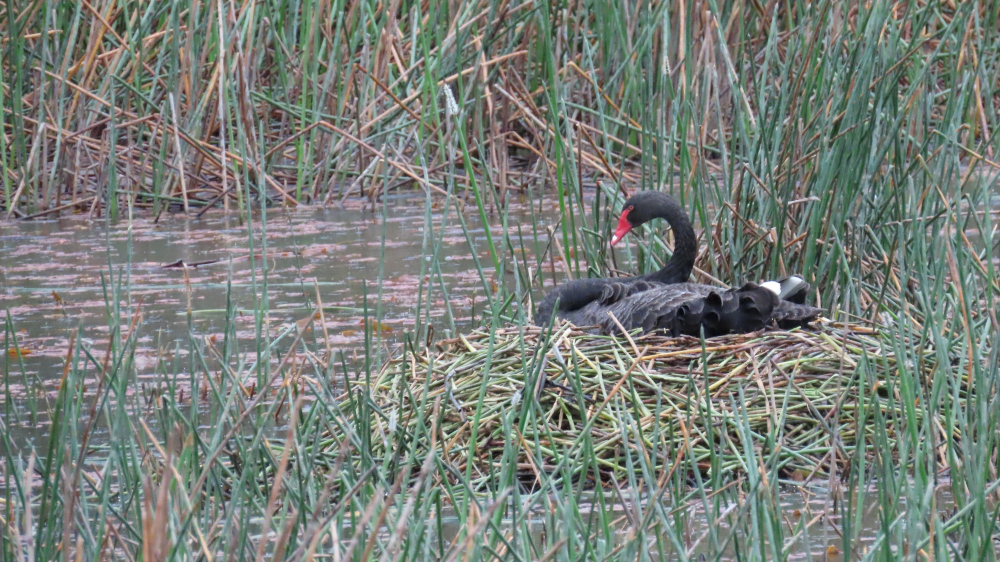
(Photo taken on 24 August 2024)
The setting is tranquil and pretty:
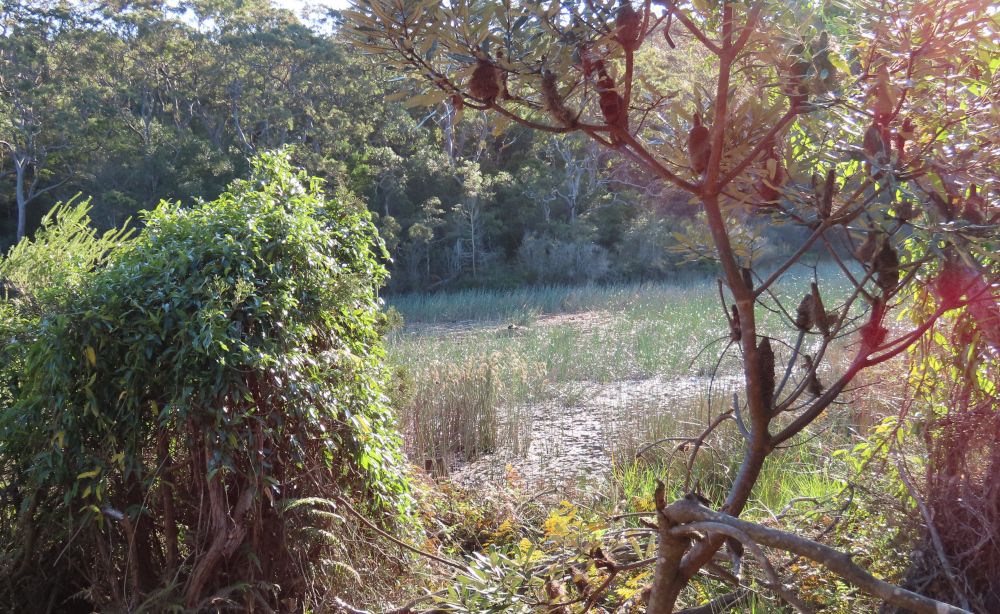
(Photo taken on 2 September 2024)
The nest is near a popular bush walking path, and I’ve walked past it every few days. When the first period of 45 days went by with no cygnets appearing, I thought maybe the parents had decided that their first batch of eggs was infertile and had started again.
But now the second period of 45 days is well and truly passed, and I’m worried.
Both the male and the female swan are still actively looking after the nest. I’ve seen each of them sitting on the nest alone, and occasionally both of them tending the nest together. The nest is never without one of the swans sitting or standing over it.

(Photo taken on 3 October 2024)
The male and female take turns to sit on the nest. The next video shows the changing of the guard. One bird has been sitting all night, the other has arrived for the morning shift. One of the birds grooms itself, and they both do a bit of nest maintenance. If you listen carefully, you can hear the swans’ soft hoots as they chat to each other:
(Video taken on 1 October 2024)
Every now and then, the swans spend quite some time and energy clearing the reeds around the nest and building up the nest:

(Photo taken on 3 October 2024)
Despite the nest’s seclusion, plenty of ducks, coots, and moorhens swim around the nest, keeping the swans company. Every now and then other visitors appear, like this kookaburra:

(Photo taken on 4 October 2024)
And this Eastern Water Dragon:

(Photo taken on 17 November 2024)
On 1 October, a beautiful light-coloured Grey Goshawk made an appearance near the nest, and was chased away by currawongs and cockatoos:

(Photo taken on 1 October 2024. I wrote another post about the goshawk.)
Here’s a nice video of one of the swans seating itself carefully on the nest:
(Video taken on 28 October 2024)
In more recent days, the site of the nest has become less tranquil. Cicadas have crept up from the earth to celebrate the summer full blast, as only cicadas can do. Sulphur-crested Cockatoos collect in the tree tops, high above the nest. The cockatoos squawk and yell, outdoing even the cicadas. It’s a very noisy environment for a nest, but at least it gives the parent swans some company. At this stage, they’d been sitting on the nest for more than 100 days:
(Video taken on 29 November 2024)
When it’s their turn for a break from sitting on the nest, one of the adults heads off to another part of the dam to stretch and feed. Here, a pelican keeps the off-duty swan company:
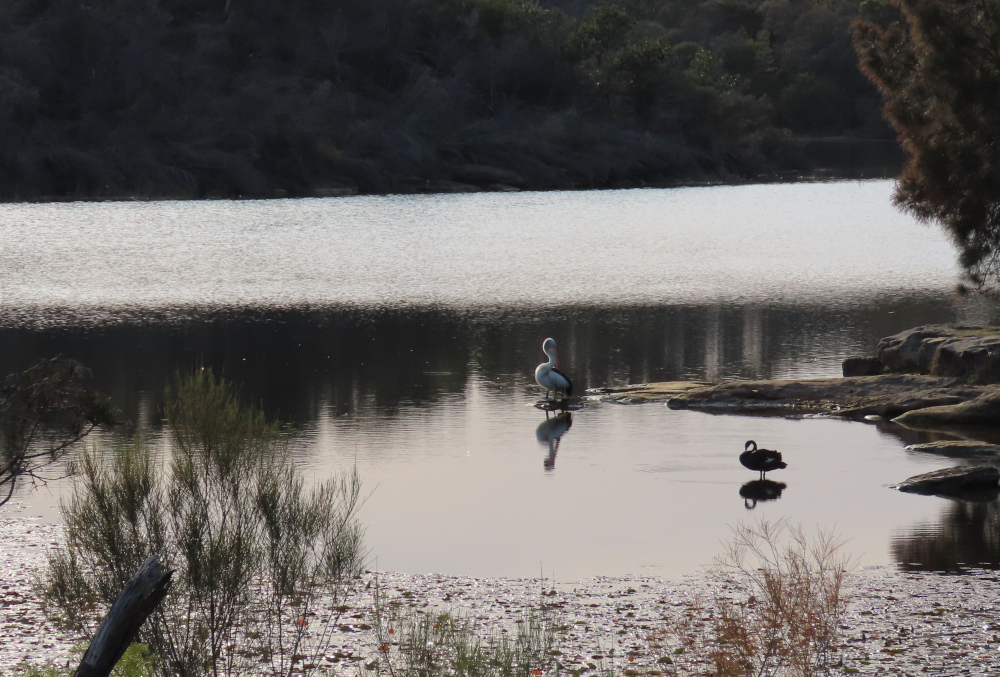
(Photo taken on 9 September 2024)
It’s good to stretch and preen:
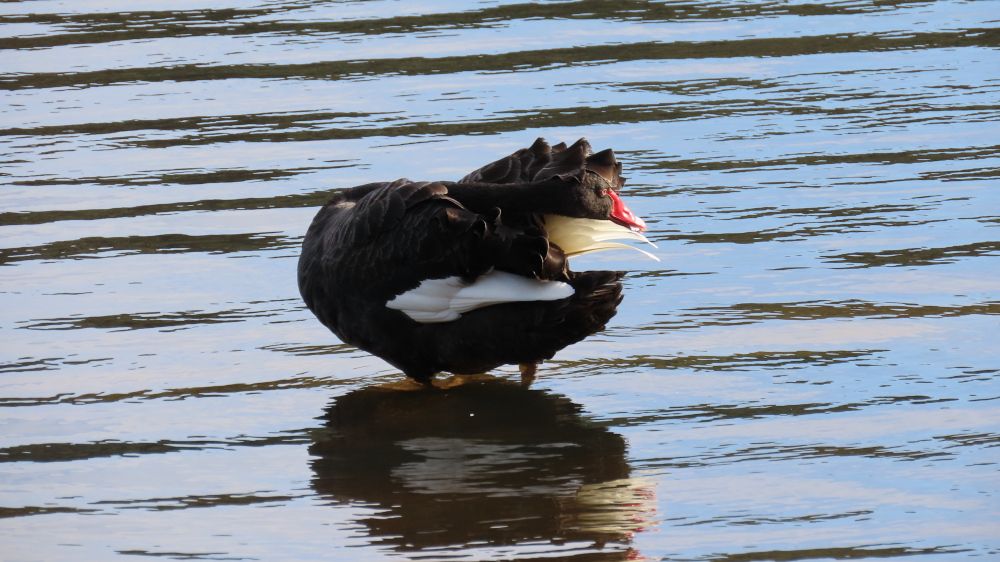
(Photo taken on 9 September 2024)
In the next video, one of the swans comes in close to shore for a good stretch. Eastern Koel cuckoos and cicadas dominate the sound waves. On a rock nearby, an Eastern Water Dragon looks on:
(Video taken on 21 November 2024)
In the next video, a Great Cormorant watches on as the swan preens and fluffs its wings. Cockatoos, Eastern Koels, and Channel-billed cuckoos call in the distance:
(Video taken on 29 November 2024)
As I write this post, December has arrived and the bush has a surfeit of insects. It’s very noisy at the swans’ nest. Two kookaburras dropped by and chatted a bit. Moths flap past, cicadas shriek, and a dead heat beats down on the nest:
(Video taken on 6 December 2024)
The last time I visited the nest was yesterday, 8 December. The swans were still sitting. Two kookaburras dropped by again and the cicadas were still very noisy.
I’ll keep a look out to see what’s happening at the nest next time I pass. I do hope to see the two swans relieved of their nesting duties. It would be wonderful to see some little ones to reward their amazing dedication. Even if there are no cygnets, though, it’d be good to see the adults roaming free again, ready for another go at raising a family next year.

(Photo taken on 8 December 2024)
Good luck, patient swans!
Update on 10 April 2025: Black Swans abandon nest after 8 months (part 2 of story).
Common name: Black Swan
Scientific name: Cygnus atratus
Approximate length: 120 cm
Date spotted: 23 August through to 8 December, 2024 (late winter, through spring, going into early summer)
Approximate location: Manly Dam Park, New South Wales, Australia
Angry duck
This male Hardhead (on the right of the picture) looks like he has something to say. To his left, a Pacific Black Duck seems mildly surprised, or perhaps just living up to his scientific name, Anas superciliosa.

And perhaps the Hardhead thinks that his mate is paying too much attention to his supercilious rival!
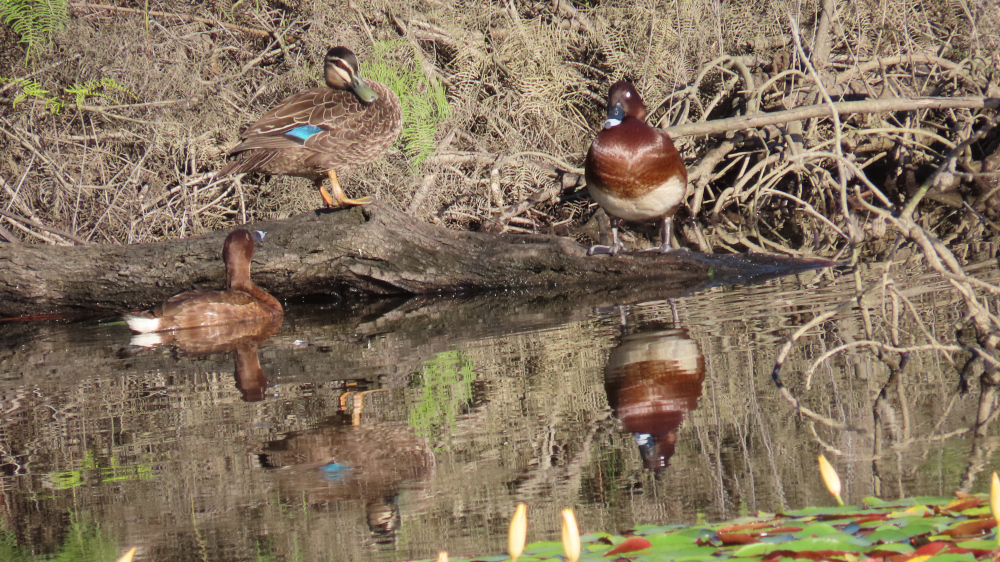
This is the first time I’ve photographed a Hardhead. Evidently they’re the only Australian duck that can claim the name of true diving ducks, as they dive deep into the water to feed. The males have white eyes while the females have brown eyes.
Common names: Hardhead and Pacific Black Duck
Scientific names: Aythya australis and Anas superciliosa
Approximate length: 45-60 cm and 48-60 cm
Date spotted: 2 December 2024 (summer)
Location: Manly Dam National Reserve, near Sydney, Australia: 33°46’34.8″S 151°14’49.6″E








